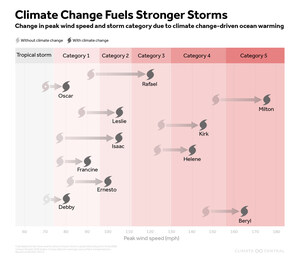New index reveals influence of climate change on local weather in real time
PRINCETON, N.J., June 21, 2022 /PRNewswire/ -- Climate Central today launched the Climate Shift Index, the world's first tool to quantify the impact of climate change on local weather in real time. Based on peer-reviewed science, the Climate Shift Index offers a clear and accessible way for communicators, including weathercasters and other media professionals, to explain climate change connections to local conditions as they happen.
The Climate Shift Index (CSI) reveals the level of influence of carbon emissions on daily high and low temperatures covering the entire continental U.S., shown on a simple numeric scale. CSI levels indicate how much more likely or frequent high temperatures and overnight lows have become in a warmer climate.
For example, a CSI level of 2 means the day's temperature was made at least 2x more likely, or twice as frequent than it would have been without human-caused climate change. A CSI level of 5 means local temperatures were made at least 5x more likely. The CSI also indicates where daily temperatures have become less likely in a warming world. The tool displays a color-coded map to show CSI levels for high and low temperatures for the current day, previous day, and the next two days.
The CSI is based on observation- and model-based calculations detailed in a methods paper, "A multi-method framework for global real-time climate attribution," published this month in Advances in Statistical Climatology, Meteorology and Oceanography.
"Climate change is invisible to most people, but it already affects our daily lives. When it's too hot to safely work outside, play sports, or walk down a city street, the Climate Shift Index will reveal its fingerprint. When crops wilt, when tornadoes or fires erupt in unseasonal heat, the Climate Shift Index can put those events in context," Benjamin Strauss, Climate Central CEO and chief scientist, and co-author of the methods paper said. "The Climate Shift Index will inform everyday conversations with the science of how our lives and communities are changing around us."
Assessing how climate change impacts daily weather adds a critical dimension to attribution science, according to co-author Friederike Otto, senior lecturer in Climate Science at Imperial College London, and co-lead of World Weather Attribution: "When extreme weather occurs, we talk about climate change–when it hits us in the face. But climate change is affecting weather every day, temperatures most strongly, with consequences we haven't even started to think about, let alone calculate and prevent. To truly adapt, we need to first understand the impacts of climate change more comprehensively. Starting with daily temperatures is an important complement to the changes in extremes we look at in WWA."
Paul Douglas, co-founder and senior meteorologist at U.S. weather consultancy Praedictix, said, "New times require new tools, and the Climate Shift Index marks a significant advance in statistically-derived alerting that will ultimately save lives, taking the emerging science of climate attribution and meteorological messaging to an entirely new level. CSI will rapidly become an essential tool for city planners, meteorologists and risk mitigation."
- CSI levels for yesterday, today, and the following two days–for daily local high and low temperatures in the continental U.S. are available at: https://www.climatecentral.org/tools/climate-shift-index
- More information about Climate Central's CSI and attribution program, Realtime Fingerprints, is available at https://www.climatecentral.org/realtime-fingerprints
- The peer-reviewed methods paper detailing the framework beneath the CSI is available at: https://ascmo.copernicus.org/articles/8/135/2022/
SOURCE Climate Central

WANT YOUR COMPANY'S NEWS FEATURED ON PRNEWSWIRE.COM?
Newsrooms &
Influencers
Digital Media
Outlets
Journalists
Opted In





Share this article